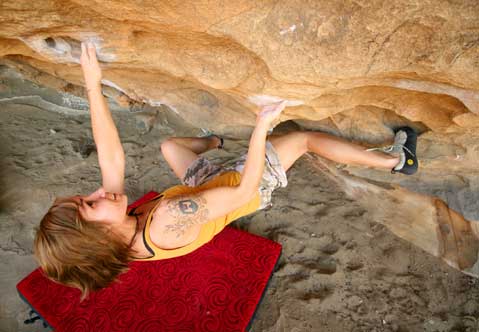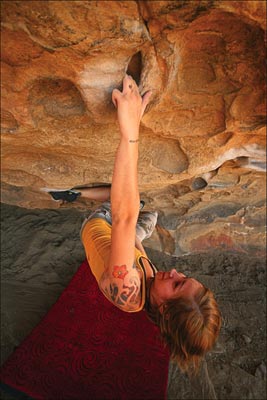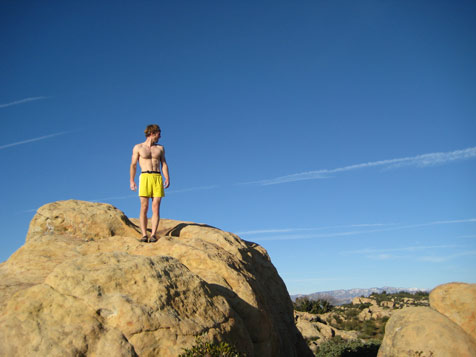A Guide to Bouldering Lingo
Chalk Up & Pull Down with the Best of Them

If you have friends who engage in animated conversations about “crimps” and “slopers,” spend their time swapping “beta,” or whine about their “shredded tips,” there’s only one rational explanation: You’re hanging out with boulderers. Devotees of bouldering-a form of rope-free rock climbing that requires little gear-are thick on the ground here in Santa Barbara County, where the foothills feature a number of porous sandstone formations famed for their climbable nature. Strong fingers, a strong core, and good flexibility are key, but bouldering appeals equally to athletic outdoor lovers and technical thinkers; bouldering routes are called “problems,” and often require the same kind of patient tinkering as mathematical equations.
Though there are certainly rules of etiquette surrounding the sport, respectful beginners are welcome. Unlike surfers, boulderers tend to be fairly non-territorial about their turf-just as long as you stay off of fragile sandstone for several days after a rainstorm-but newcomers are likely to find the new vernacular as challenging as the climbing itself. Bouldering problems tend to have names as obscure as racehorses-“Grotesque Old Woman,” “Martini Madness,” and “The Dancing Outlaw” spring to mind-and the list of technical and slang terms used by those in the know is virtually endless. If you’re interested in checking it out, study up on the following terms-they’ll give you a chance at following the thread of conversation, even if you can’t follow your buddies to the top of the rock Beta: tips on climbing a particular problem

Choss: loose rock of questionable quality
Crash pad: a pad placed below the boulderer to reduce the risk of injury
Crimp: a small edge that requires wrapping the thumb over the index finger and pulling with the fingertips
Dyno: short for “dynamic movement”: a swift move-often a jump-from one hold to the next
Flapper: what happens to your fingers when your calluses wear out
Flash: to complete a problem on the first attempt
Gaston: a hold that requires you to pull away from your core rather than toward it
Heel hook: a method of using the heel on a hold to create body tension
Highball: a tall bouldering problem, where falling could have serious consequences
Hold: any part of the rock that can be used to ascend a problem
Hueco: an area of rock that has fallen away, sometimes due to erosion (“hollow” in Spanish)
Jug: a secure hold large enough for the hand to fit inside
Lie Back: a method of leaning away from the rock with the arms straight in order to create body tension

Mantle: levering the body on top of a ledge by pulling up and then pushing down on the ledge
Matching: placing both hands or both feet on the same hold temporarily
On-sight: to complete a problem on the first attempt without ever having seen the problem and without any beta
Pinch: pinching a small hold between the thumb and fingers, or a hold that requires such an action
Pocket: a small hole in the rock (i.e.: a mono, a two-finger pocket, a three-finger pocket, etc.)
Problem: a sequence of holds leading to the top of a boulder
Send: to successfully ascend the rock (see “top out”)
Sit Start: a problem that is designed to be started from a seated position
Sloper: a hold composed of a sloping surface with no edges to crimp
Spotter: a friend who stands beneath you to guide you to the crash pad in case you fall
Top Out: to successfully ascend a problem (see “send”)
Traverse: to move laterally across the rock
Undercling: a hold that requires pulling up rather than down
V-Scale: an open-ended measure of difficulty assigned to bouldering problems; currently ranging from V0 (easy) to V15 or V16 (nearly impossible). Named after John “The Vermin” Sherman, who developed the system at the bouldering mecca of Hueco Tanks, Texas.
• For a great guide to bouldering in the Santa Barbara area, check out Ocean’s Eleven by Bob Banks, which includes maps and ratings for problems in 10 bouldering areas in the region. (It used to be 11, but fire and subsequent flooding in 2005 mostly destroyed the bouldering area in Tar Creek.)



